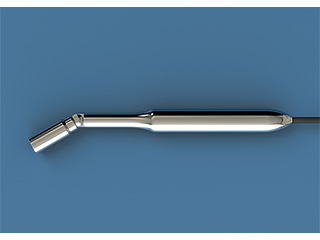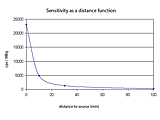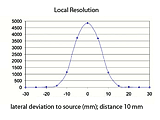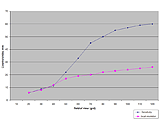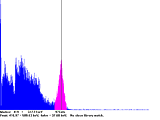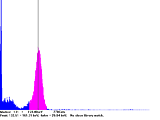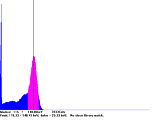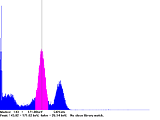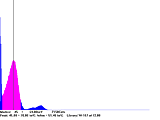Flexible Gamma Probe: "FlexProbe"
1. Description
Our FlexProbe combines two probe options in one, because it can be used as a straight or as an angled probe (0°-30°)! The 3 cm sensing head is continously adjustable during surgery to locate SLN's in difficult geometrical positiones.
FlexProbe uses the same collimator sleeves as the Straight-probe "HiSens". In combination with the standard collimator sleeve (40°) FlexProbe has a very high sensitivity (> 20.000 Counts/s/MBq), an excellent side shielding (99,97%) and an optimal spatial resolution (< 17 mm) at a probe tip diameter of 15 mm.
FlexProbe is designed for the radiation energy of the most used nuclide 99mTc (140 keV) and has optimal parameters for it. The detectable energy range is from 70 keV (201Tl) up to 511keV (PET nuclide). The collimators are built into stainless steel tubes that can be unscrewed and steam sterilized separately. When used intraoperatively the probe has to be protected by a sterile latex cover, as for example used in ultrasound diagnostics.
2. Technical Data
| Detector | CsI:Tl-scintillation crystal Ø 6 mm x 8 mm long, read out by a 20 mm2 pin-photodiode |
| Gamma-energy range | 60 keV … > 511 keV |
| Probe properties | length: 210 mm; length of cable: 3 m diameter hand piece: 20 mm diameter of tip: 15 mm weight: about 7 ounce (200 g) |
| Special features | 6 different collimator sleeves available |
2.1 Collimation and Side-shielding
| Material | Tungsten, lateral thickness 3,15 mm (at all collimator sleeves with D = 15 mm), rear thickness 5 mm side shielding = 99,97 % @ 140 keV (99mTc) |
| Dihedral angle (FOV) | Standard 40° FWHM, changeable by 6 different collimator sleeves |
2.2 Background sensitivity
Zero effect < 0,3 cps = 18 c/min
2.3 Sensitivity and Resolution
The sensitivity of the probe depends on the used collimator. The basic sensitivity is determined by the standard collimator (40°). The sensitivity is shown in the figure - its depending on the distance between lymph-node and probe tip. The probe FlexProbe has a high sensitivity > 20.000 counts/s/MBq.
The angular resolution with a standard collimator (40°) is determined in the near field (distance: 3 cm) and in the far field (distance: 10 cm).
The spatial resolution with a standard collimator (40°) is determined in the near field (distance: 1 cm). The probe has an excellent spatial resolution < 17 mm.
Spatial resolution, angular resolution and sensitivity depend strongly on the actual measurement conditions and from the selected collimator geometry. In the table spatial resolution and sensitivity of different collimators were determined in a water phantom.
| (distance tip-source: 30 mm) | collimator dihedral angle | |||
| 40° | 90° | 120° | ||
| local resolution in air | mm | 23 | 40 | 46 |
| local resolution in water | mm | 24 | 40 | 47 |
| sensitivity in air | Counts/MBq | 690 | 1360 | 1538 |
| sensitivity in water | Counts/MBq | 585 | 1120 | 1154 |
2.4 Energy spektra
The energy spectra of the FlexProbe, recorded with nuclides used most in medicine:

